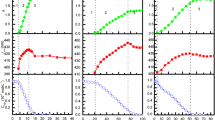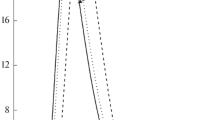Abstracts
The effect of the solubility of insoluble silver chromates in the formation of Liesegang rings has been studied as this insoluble salt shows a marked yariation in its solubility with the change in hydrogen ion concentration.
The Liesegang rings are less closely packed as the solubility of silver chromate is increased with the increasing acidity of the medium.
Rings become more distinct as the chromate solutions used are diluted or the concentrated solution of silver nitrate diffusing from the top is diluted. There should be considerable difference in the concentrations of the two interacting solutions, the one diffusing from the top being always concentrated. Concentrations of the interacting solutions, suited for well defined rings in the gelatin medium, have been determined.
Zusammenfassung
Es wurde die Wirkung der Löslichkeit von Silberchromat bei der Bildung von Liesegang-Ringen untersucht, da dieses weitgehend unlösliche Salz eine starke Variation seiner Löslichkeit bei Änderung der Wasserstoffionenkonzentration zeigt. Liesegang-Ringe besitzen größere Abstände bei gesteigerter Löslichkeit des Silberchromats durch höhere Azidität des Mediums.
Die Ringe werden schärfer, wenn verdünnte Chromatlösungen oder Nitratlösungen verwendet werden. Es müssen beträchtliche Unterschiede in der Konzentration der zwei reagierenden Lösungen bestehen, wobei die von außen diffundierende immer die konzentriertere sein muß. Die günstigsten Konzentrationsverhältnisse wurden bestimmt.
Similar content being viewed by others

References
Liesegang, Phot. Archiv.,1896, 221. Z. anorg. Chem.,48, 364 (1906). Kolloid-Z.,2, 70; (1907),9, 296, (1911),10, 225. (1912).
Dhar and Chatterji, Kolloid-Z.,31, 15 (1922); J. Physical Chem.,28, 41 (1924); Kolloid-Z.37, 2, 89 (1925); Z. anorg. Chem.,159, 129, 186 (1927); Trans. Faraday Soc.,23, 23 (1927); J. Indian Chem. Soc.,5, 175 (1928).
Chatterji and Coworkers, J. Indian Chem. Soc.,26, 529 (1949);28, 128, 158, 283, 732 (1951).
Bradford, Biochem. J.,14, 474 (1920). Alexander's „Colloid Chemistry“, p. 790 (New York 1926).
Hedges and Henley, J. Chem. Soc.,1928, 2714.
Hedges, Liesegang rings and other periodic structures (London, 1932).
Dhar and Chatterji, loc. cit.
Author information
Authors and Affiliations
Rights and permissions
About this article
Cite this article
Varma, K.K., Ghosh, S. Liesegang rings of silver chromate. Kolloid-Zeitschrift 133, 32–34 (1953). https://doi.org/10.1007/BF01513902
Received:
Issue Date:
DOI: https://doi.org/10.1007/BF01513902



